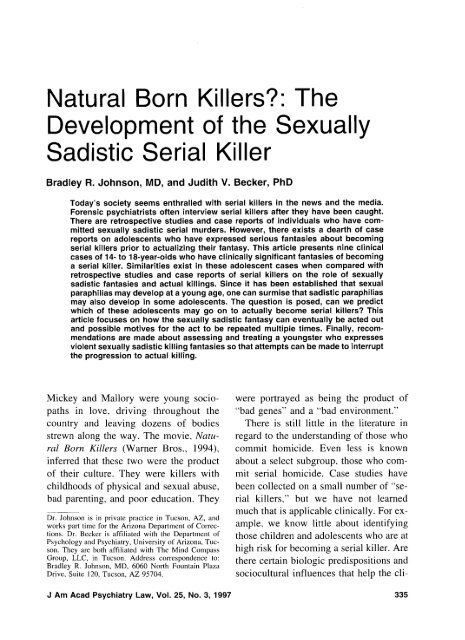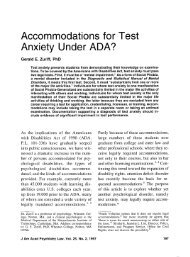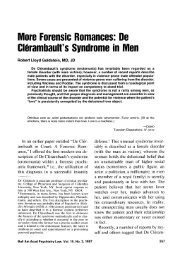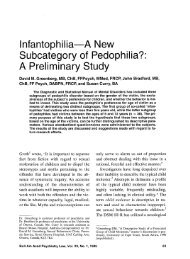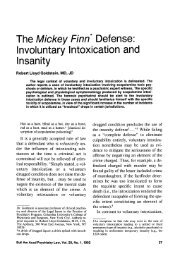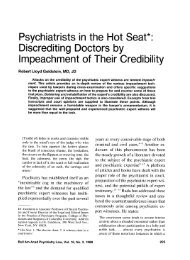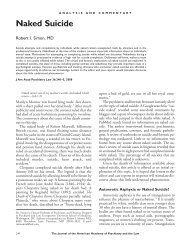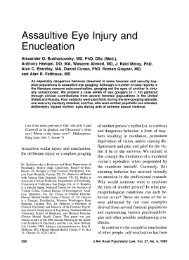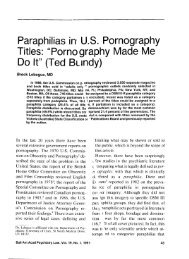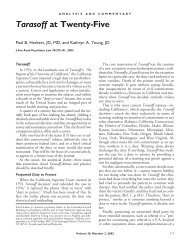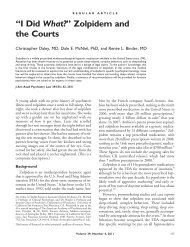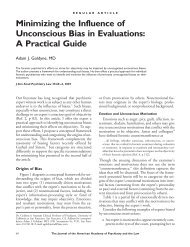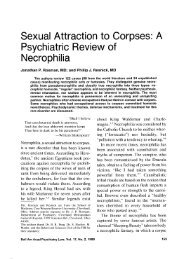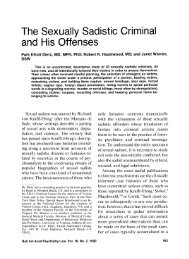Natural Born Killers? - Journal of the American Academy of ...
Natural Born Killers? - Journal of the American Academy of ...
Natural Born Killers? - Journal of the American Academy of ...
Create successful ePaper yourself
Turn your PDF publications into a flip-book with our unique Google optimized e-Paper software.
<strong>Natural</strong> <strong>Born</strong> <strong>Killers</strong>?: The<br />
Development <strong>of</strong> <strong>the</strong> Sexually<br />
Sadistic Serial Killer<br />
Bradley R. Johnson, MD, and Judith V. Becker, PhD<br />
Today's society seems enthralled with serial killers in <strong>the</strong> news and <strong>the</strong> media.<br />
Forensic psychiatrists <strong>of</strong>ten interview serial killers after <strong>the</strong>y have been caught.<br />
There are retrospective studies and case reports <strong>of</strong> individuals who have com-<br />
mitted sexually sadistic serial murders. However, <strong>the</strong>re exists a dearth <strong>of</strong> case<br />
reports on adolescents who have expressed serious fantasies about becoming<br />
serial killers prior to actualizing <strong>the</strong>ir fantasy. This article presents nine clinical<br />
cases <strong>of</strong> 14- to 18-year-olds who have clinically significant fantasies <strong>of</strong> becoming<br />
a serial killer. Similarities exist in <strong>the</strong>se adolescent cases when compared with<br />
retrospective studies and case reports <strong>of</strong> serial killers on <strong>the</strong> role <strong>of</strong> sexually<br />
sadistic fantasies and actual killings. Since it has been established that sexual<br />
paraphilias may develop at a young age, one can surmise that sadistic paraphilias<br />
may also develop in some adolescents. The question is posed, can we predict<br />
which <strong>of</strong> <strong>the</strong>se adolescents may go on to actually become serial killers? This<br />
article focuses on how <strong>the</strong> sexually sadistic fantasy can eventually be acted out<br />
and possible motives for <strong>the</strong> act to be repeated multiple times. Finally, recom-<br />
mendations are made about assessing and treating a youngster who expresses<br />
violent sexually sadistic killing fantasies so that attempts can be made to interrupt<br />
<strong>the</strong> progression to actual killing.<br />
Mickey and Mallory were young socio-<br />
paths in love, driving throughout <strong>the</strong><br />
country and leaving dozens <strong>of</strong> bodies<br />
strewn along <strong>the</strong> way. The movie, Natu-<br />
ral <strong>Born</strong> <strong>Killers</strong> (Warner Bros., 1994),<br />
inferred that <strong>the</strong>se two were <strong>the</strong> product<br />
<strong>of</strong> <strong>the</strong>ir culture. They were killers with<br />
childhoods <strong>of</strong> physical and sexual abuse,<br />
bad parenting, and poor education. They<br />
Dr. Johnson is in private practice in Tucson, AZ, and<br />
works part time for <strong>the</strong> Arizona Department <strong>of</strong> Correc-<br />
tions. Dr. Becker is affiliated with <strong>the</strong> Department <strong>of</strong><br />
Psychology and Psychiatry, University <strong>of</strong> Arizona, Tuc-<br />
son. They are both affiliated with The Mind Compass<br />
Group, LLC, in Tucson. Address correspondence to:<br />
Bradley R. Johnson, MD, 6060 North Fountain Plaza<br />
Drive, Suite 120, Tucson, AZ 95704.<br />
were portrayed as being <strong>the</strong> product <strong>of</strong><br />
"bad genes" and a "bad environment."<br />
There is still little in <strong>the</strong> literature in<br />
regard to <strong>the</strong> understanding <strong>of</strong> those who<br />
commit homicide. Even less is known<br />
about a select subgroup, those who com-<br />
mit serial homicide. Case studies have<br />
been collected on a small number <strong>of</strong> "se-<br />
rial killers," but we have not learned<br />
much that is applicable clinically. For ex-<br />
ample, we know little about identifying<br />
those children and adolescents who are at<br />
high risk for becoming a serial killer. Are<br />
<strong>the</strong>re certain biologic predispositions and<br />
sociocultural influences that help <strong>the</strong> cli-<br />
J Am Acad Psychiatry Law, Vol. 25, No. 3, 1997 335
nician identify children who will grow up<br />
to become serial killers?<br />
As one looks back at <strong>the</strong> childhoods <strong>of</strong><br />
such notorious killers as Ted Bundy, John<br />
Wayne Gacey, Dennis Nilsen, David<br />
Berkowitz, or Jeffrey Dahmer, it is im-<br />
portant to see whe<strong>the</strong>r <strong>the</strong>re were clues<br />
early in <strong>the</strong>ir lives that would have helped<br />
identify <strong>the</strong>ir homicidal tendencies before<br />
<strong>the</strong>y had committed violent crimes. Al-<br />
though many would believe that a serial<br />
killer may not be treatable once he or she<br />
has begun to kill, one wonders whe<strong>the</strong>r, if<br />
<strong>the</strong>y had been identified early enough,<br />
treatment might have succeeded in pre-<br />
venting <strong>the</strong>m from actually starting <strong>the</strong>ir<br />
streams <strong>of</strong> killing.<br />
It appears that children and adolescents<br />
are committing more and more violent<br />
crimes at an earlier age.' The authors<br />
would propose that many adolescents are<br />
developing fantasies at early ages about<br />
committing violent crimes such as mur-<br />
der. As will be initially presented in case<br />
examples, <strong>the</strong>re are adolescents who are<br />
even experiencing fantasies <strong>of</strong> becoming<br />
serial killers. One would wonder if <strong>the</strong>se<br />
individuals are at a high risk for acting<br />
out <strong>the</strong>ir homicidal fantasies.<br />
Case Presentations<br />
Nine adolescents who expressed a de-<br />
sire to commit serial killings have been<br />
identified. Most <strong>of</strong> <strong>the</strong>se youth were re-<br />
ferred to <strong>the</strong> authors for a forensic eval-<br />
uation after having committed a legal <strong>of</strong>-<br />
fense. A few were referred, secondary to<br />
a mental health worker becoming con-<br />
cerned about an unusual behavior, for a<br />
psychological or psychiatric evaluation.<br />
None were referred for having already<br />
Johnson and Becker<br />
expressed homicidal fantasies to a prior<br />
evaluator.<br />
Case 1 L. was a 14-year-old white<br />
male who was admitted to a psychiatric<br />
unit after attempting suicide by hanging.<br />
He reported feeling depressed and said. "I<br />
feel like I'm going crazy . . . every day I<br />
have to decide if I should live or kill<br />
myself."<br />
Although initially hesitant, L. began to<br />
speak about why he felt he was "going<br />
crazy." He reported having obsessional<br />
thoughts <strong>of</strong> killing o<strong>the</strong>r people. In fact,<br />
he admitted to having a plan <strong>of</strong> breaking<br />
into a strange woman's house, capturing<br />
her, raping her, and <strong>the</strong>n stabbing her to<br />
death. He said, "I want to be a serial<br />
killer."<br />
L. admitted to using his BB gun as a<br />
teenager to kill various animals in <strong>the</strong><br />
area around his house. At <strong>the</strong> time <strong>of</strong> his<br />
admission, he had been killing up to 10<br />
animals per day including birds, rabbits,<br />
cats, and dogs. He would shoot <strong>the</strong>m,<br />
drown <strong>the</strong>m, stab <strong>the</strong>m. or light <strong>the</strong>m on<br />
fire while <strong>the</strong>y were alive. to kill <strong>the</strong>m.<br />
L. was intelligent, having tested at an<br />
IQ <strong>of</strong> 122. Despite his high IQ, he did<br />
poorly in school. The evaluators felt that<br />
he was a clean-cut and attractive young<br />
man and very likable. He had fantasies <strong>of</strong><br />
killing his mo<strong>the</strong>r by blunt force to <strong>the</strong><br />
head with a hammer until "her brains<br />
were completely exposed." He also dis-<br />
cussed a recently released movie, "Si-<br />
lence <strong>of</strong> <strong>the</strong> Lambs" (Orion Pictures,<br />
1990). He identified himself with <strong>the</strong><br />
character Hannibal Lecter. seeing <strong>the</strong> por-<br />
trayed serial killer as having "total control<br />
over o<strong>the</strong>r people." He went on to express<br />
that he wanted to be like him, killing over<br />
336 J Am Acad Psychiatry Law, Vol. 25, No. 3, 1997
<strong>Natural</strong> <strong>Born</strong> <strong>Killers</strong>?<br />
100 people, being apprehended, going to<br />
prison, and seeing himself on TV. He<br />
said, "<strong>the</strong>n, I'd be famous." He denied<br />
any sexual excitement when having<br />
thoughts <strong>of</strong> killing and denied any para-<br />
philic fantasies or behaviors.<br />
Case 2 S. was a 16-year-old white<br />
male who was referred by a concerned<br />
social worker after he had admitted to<br />
multiple animal killings. He gained an<br />
interest in dissecting animals following a<br />
worm dissection exercise in his sixth<br />
grade science class. In <strong>the</strong> eighth grade,<br />
he stole a fetal pig from his biology class<br />
and dissected it on his own. He became<br />
curious about <strong>the</strong> textures <strong>of</strong> <strong>the</strong> animal<br />
tissues, tasted parts <strong>of</strong> it, and recalled<br />
becoming sexually excited by <strong>the</strong> dissec-<br />
tion. S. volunteered at an emergency<br />
room near his house where he eventually<br />
asked to witness a human autopsy, but<br />
this experience was denied him. He had a<br />
juvenile court history including shoplift-<br />
ing and runaway.<br />
S. tested at an above-average IQ <strong>of</strong><br />
125, although he did relatively poorly in<br />
school. He abused alcohol, sleeping pills,<br />
and marijuana when he became a teen-<br />
ager.<br />
At <strong>the</strong> age <strong>of</strong> 15, S. began to kill ani-<br />
mals. First, he killed a cat, and went on to<br />
kill rabbits, birds, dogs, ducks, and o<strong>the</strong>r<br />
cats. He usually killed via strangulation<br />
or stabbing. The animals skulls were pre-<br />
pared and proudly mounted as trophies in<br />
his bedroom. On one occasion, he became<br />
sexually excited while killing an animal<br />
and placed his erect penis inside <strong>the</strong> open<br />
wound <strong>of</strong> <strong>the</strong> animal and masturbated.<br />
S. admitted to fantasies <strong>of</strong> killing hu-<br />
mans including recurrent thoughts <strong>of</strong> rape<br />
ending in strangulation, necrophilia, and<br />
body mutilation. He fantasized about<br />
keeping <strong>the</strong> sexual organs and skulls as<br />
trophies. He also described o<strong>the</strong>r sexually<br />
sadistic fantasies that always ended in<br />
death. Additional paraphilic fantasies in-<br />
cluded voyeurism, exhibitionism. uro-<br />
philia, fetishistic cross dressing, frotteur-<br />
ism, and bestiality. He had a long history<br />
<strong>of</strong> masturbation to pornographic materi-<br />
als.<br />
Finally, S. had a long history <strong>of</strong> mild<br />
depression, and vague paranoid delusions<br />
and described occasionally hearing ill-<br />
defined voices.<br />
Case 3 D. was a 17-year-old Hispanic<br />
male who claimed a history <strong>of</strong> ingesting<br />
human blood. He liked to prick his own<br />
finger or lick <strong>the</strong> bleeding wound <strong>of</strong> a<br />
friend or family member. He had a sub-<br />
stantial history <strong>of</strong> assaulting o<strong>the</strong>r adoles-<br />
cents and adults, explaining that such sit-<br />
uations made him feel in "total control."<br />
D. reported being ra<strong>the</strong>r intelligent but<br />
dropped out <strong>of</strong> school secondary to poor<br />
grades. He denied being depressed but<br />
admitted to having frequent thoughts <strong>of</strong><br />
death. He had a questionable history <strong>of</strong><br />
panic attacks or possible dissociative ep-<br />
isodes. Additionally, he had an extensive<br />
history <strong>of</strong> polysubstance abuse including<br />
paint sniffing.<br />
D. recalled seeing <strong>the</strong> movie "Silence<br />
<strong>of</strong> <strong>the</strong> Lambs" where he became very<br />
emotionally "excited" by <strong>the</strong> scene show-<br />
ing a human that had been cut open. hung<br />
up, and <strong>the</strong> internal organs <strong>of</strong> <strong>the</strong> body<br />
displayed. Since <strong>the</strong>n, he admitted to hav-<br />
ing become enthralled by <strong>the</strong> viscera <strong>of</strong><br />
humans.<br />
D. described having fantasies <strong>of</strong> killing<br />
J Am Acad Psychiatry Law, Vol. 25, No. 3, 1997 337
multiple people in a fashion like "Dah-<br />
mer." He discussed fantasies <strong>of</strong> cutting<br />
<strong>the</strong>m open, playing with <strong>the</strong> viscera, cut-<br />
ting <strong>the</strong> appendages <strong>of</strong>f, and burying <strong>the</strong><br />
various body parts in specific locations<br />
around <strong>the</strong> town in which he resided.<br />
Fur<strong>the</strong>rmore, he had fantasies <strong>of</strong> eating<br />
parts <strong>of</strong> <strong>the</strong> corpses.<br />
D. became sexually active at <strong>the</strong> age <strong>of</strong><br />
12 and had had over 100 sexual partners.<br />
He denied any history <strong>of</strong> sexual para-<br />
philias.<br />
Case 4 B. was a 14-year-old Hispanic<br />
female who was referred for a presentenc-<br />
ing evaluation for grand <strong>the</strong>ft auto and<br />
runaway. She expressed that one <strong>of</strong> her<br />
goals in life was to become <strong>the</strong> "first<br />
teenage serial killer."<br />
B. had been previously diagnosed with<br />
bipolar disorder, although <strong>the</strong> diagnosis<br />
appeared to be questionable given her<br />
history and presentation. It was apparent<br />
that she suffered from dysthymia and had<br />
low self-esteem and a history <strong>of</strong> occa-<br />
sional suicidal ideation. Fur<strong>the</strong>rmore, she<br />
was diagnosed with a conduct disorder<br />
and cannabis dependence. There was no<br />
history <strong>of</strong> psychosis.<br />
B. had been an average student in<br />
school and had never undergone any type<br />
<strong>of</strong> psychological testing. She became sex-<br />
ually active at <strong>the</strong> age <strong>of</strong> 12 and admitted<br />
to a history <strong>of</strong> frotteurism with many<br />
boys. She also enjoyed watching sexually<br />
explicit movies. She reported that her best<br />
friend was a 40-year-old woman who al-<br />
lowed her to watch as she engaged in<br />
lesbian sexual encounters.<br />
B. reported having a recurrent dream<br />
about someone trying to chase her and<br />
stab her repeatedly with a knife. In real-<br />
Johnson and Becker<br />
ity, however, she had experienced a sig-<br />
nificant history <strong>of</strong> abuse including being<br />
sexually molested by her mo<strong>the</strong>r's boy-<br />
friend at <strong>the</strong> age <strong>of</strong> 6 and raped by an<br />
adolescent boy at <strong>the</strong> age <strong>of</strong> 13. As a<br />
child, she witnessed her fa<strong>the</strong>r brutally<br />
rape and beat her mo<strong>the</strong>r including force-<br />
ful insertion <strong>of</strong> foreign objects into her<br />
mo<strong>the</strong>r's vagina and anus. Her fa<strong>the</strong>r<br />
served time for attempted murder and had<br />
a significant history <strong>of</strong> killing neighbor-<br />
hood dogs by running <strong>the</strong>m over on pur-<br />
pose.<br />
B. expressed having fantasies <strong>of</strong> wish-<br />
ing to "tar and fea<strong>the</strong>r" o<strong>the</strong>rs until <strong>the</strong>y<br />
died or tying individuals up to a tree.<br />
cutting and peeling <strong>the</strong>ir skin <strong>of</strong>f with a<br />
knife while <strong>the</strong>y were alive. She also fan-<br />
tasized about killing people by stabbing.<br />
She denied ever becoming sexually ex-<br />
cited by <strong>the</strong>se fantasies and denied that<br />
she had ever killed any animals.<br />
Case 5 S. was a 14-year-old white<br />
male who had been showing aggressive<br />
behaviors since <strong>the</strong> age <strong>of</strong> four. He was<br />
diagnosed with attention deficitlhyperac-<br />
tivity disorder and was reported to have<br />
suffered from frequent mood swings.<br />
At <strong>the</strong> age <strong>of</strong> 12, he developed homi-<br />
cidal fantasies about killing multiple peo-<br />
ple via strangulation or purposefully frac-<br />
turing as many <strong>of</strong> <strong>the</strong>ir bones as he could<br />
until <strong>the</strong>y died.<br />
S. was <strong>the</strong> product <strong>of</strong> a pregnancy<br />
caused by rape. His biological fa<strong>the</strong>r be-<br />
came angry when his mo<strong>the</strong>r refused to<br />
have any continued relationship with him<br />
and followed her around <strong>the</strong> country<br />
stalking her.<br />
S. did ra<strong>the</strong>r well in school, receiving<br />
above-average grades in most <strong>of</strong> his<br />
338 J Am Acad Psychiatry Law, Vol. 25, No. 3, 1997
<strong>Natural</strong> <strong>Born</strong> <strong>Killers</strong>?<br />
classes. He began to abuse alcohol and<br />
marijuana.<br />
At <strong>the</strong> age <strong>of</strong> 14, S. began to stalk a<br />
female peer. Although she asked that he<br />
not follow her. he referred to her as his<br />
girlfriend and did such things as follow<br />
her home or befriend her mo<strong>the</strong>r in order<br />
to gain entrance to her home. He admitted<br />
to stealing her underwear, which he<br />
would use when he masturbated. He also<br />
admitted to numerous situations <strong>of</strong> frot-<br />
teurism. Finally, he admitted that he had<br />
become sexually active at <strong>the</strong> age <strong>of</strong> six<br />
and recalled having been involved in sex-<br />
ual activity with two o<strong>the</strong>r females since<br />
that time.<br />
S. admitted to having killed two dogs<br />
by snapping <strong>the</strong>ir necks while <strong>the</strong>y were<br />
alive. However. he reported that his con-<br />
tinuing fantasies were about killing hu-<br />
mans ra<strong>the</strong>r than animals.<br />
Case 6 M. was an 18-year-old white<br />
male who had been diagnosed with atten-<br />
tion deficithyperactivity disorder (AD/<br />
HD) and treated with Ritalin since an<br />
early age. As an adolescent, he began to<br />
abuse <strong>the</strong> Ritalin, <strong>of</strong>ten crushing <strong>the</strong> tab-<br />
lets and sniffing it. He admitted to having<br />
feelings <strong>of</strong> depression. He was an above-<br />
average student.<br />
M. began to develop homicidal fanta-<br />
sies at <strong>the</strong> age <strong>of</strong> 12: <strong>the</strong>y involved killing<br />
multiple humans via stabbing or strangu-<br />
lation. He admitted that he was mastur-<br />
bating approximately 15 times a day<br />
while fantasizing about bondage. control.<br />
and killing.<br />
At <strong>the</strong> age <strong>of</strong> 15, M. broke into <strong>the</strong><br />
home <strong>of</strong> a strange woman and attempted<br />
to rape her. He wore a mask so as to not<br />
be identified. He was unable to penetrate<br />
her as he had wished, because she fought<br />
back. He grabbed a knife. stabbed her,<br />
and attempted to kill her. At <strong>the</strong> age <strong>of</strong> 16,<br />
he engaged in his first consensual sexual<br />
activity which he described as "bondage"<br />
and "sadistic acts" with a slightly older<br />
female.<br />
Case 7 H. was an 18-year-old white<br />
male who had suffered from AD/HD and<br />
chronic depression. He was <strong>of</strong> below av-<br />
erage intelligence with possible learning<br />
disabilities. At an early age. he recalled<br />
having been severely physically abused<br />
by his mo<strong>the</strong>r. including beating and<br />
whipping. Fur<strong>the</strong>rmore, he recalled his<br />
mo<strong>the</strong>r being very sexually provocative<br />
throughout his youth, exposing herself to<br />
him or watching him undress and making<br />
erotic comments. His parents once en-<br />
gaged in sexual intercourse in front <strong>of</strong><br />
him, and he recalled his mo<strong>the</strong>r moaning<br />
in what he felt was a haunting and death-<br />
like manner.<br />
At <strong>the</strong> age <strong>of</strong> 14, H. began to fantasize<br />
about having sexual intercourse with his<br />
mo<strong>the</strong>r while listening to her moan. kill-<br />
ing her, and continuing to have inter-<br />
course with her corpse. He admitted that<br />
he was masturbating approximately eight<br />
times a day to this fantasy, <strong>of</strong>ten using his<br />
mo<strong>the</strong>r's underwear as an erotic aid.<br />
He expressed confusion as to sexual<br />
orientation, but generally preferred het-<br />
erosexual activities. He had had over 100<br />
female sexual partners, <strong>of</strong>ten exchanging<br />
money for sex. He had also been sexually<br />
abused by a 16-year-old baby sitter at <strong>the</strong><br />
age <strong>of</strong> 10. He admitted to fantasies or<br />
prior acts <strong>of</strong> voyeurism, fetishism, cross-<br />
dressing, sadism and rape. He had a sig-<br />
nificant history <strong>of</strong> alcohol and drug<br />
J Am Acad Psychiatry Law, Vol. 25, No. 3, 1997 339
abuse. He had been diagnosed with a<br />
borderline personality disorder. He de-<br />
nied any history <strong>of</strong> killing animals.<br />
At <strong>the</strong> age <strong>of</strong> 17, he committed his first<br />
killing <strong>of</strong> an unknown woman via stran-<br />
gulation and continued to commit necro-<br />
philic acts with <strong>the</strong> corpse for at least<br />
three days.<br />
Case 8 K. was a 14-year-old white<br />
boy who was referred for a presentencing<br />
evaluation for charges <strong>of</strong> disorderly con-<br />
duct, criminal damage, <strong>the</strong>ft, carrying a<br />
concealed weapon, runaway, and domes-<br />
tic violence. He had a poor relationship<br />
with his mo<strong>the</strong>r and indeed had attempted<br />
to hit her and threatened to kill her on<br />
many occasions. He had lit many fires as<br />
a youngster and hid a knife under his bed<br />
at all times. He was diagnosed with a<br />
conduct disorder, alcohol dependence,<br />
cannabis dependence, and a possible de-<br />
pression. At <strong>the</strong> time that he entered pu-<br />
berty, he admitted having developed fan-<br />
tasies <strong>of</strong> "mass murder," but he described<br />
having thoughts <strong>of</strong> killing many people<br />
over time (i.e., serial killing).<br />
K. fantasized two to three times a day<br />
about killing. His fantasies increased dur-<br />
ing times when he was angry or de-<br />
pressed. His killing fantasies included<br />
shooting o<strong>the</strong>r people or tying people up<br />
and cutting <strong>the</strong>ir fingers, toes, or o<strong>the</strong>r<br />
limbs <strong>of</strong>f while <strong>the</strong>y were alive. He ad-<br />
mitted to killing by gunshot ano<strong>the</strong>r ado-<br />
lescent who was in an opposing gang. He<br />
denied becoming sexually excited when<br />
thinking about his fantasies or about prior<br />
acts <strong>of</strong> killing.<br />
K. reported having been molested at<br />
<strong>the</strong> age <strong>of</strong> eight by a 30-year-old homo-<br />
sexual relative who later died <strong>of</strong> AIDS. K.<br />
Johnson and Becker<br />
reported having become sexually active at<br />
<strong>the</strong> age <strong>of</strong> 13 and having had between 10<br />
and 15 sexual partners. He denied any<br />
history <strong>of</strong> paraphilic fantasies.<br />
Case 9 T. was a 17-year-old white<br />
male referred for a psychiatric evaluation<br />
after having admitted to experiencing au-<br />
ditory and visual hallucinations <strong>of</strong> "de-<br />
mons and <strong>the</strong> devil." He reported hearing<br />
voices instructing him to kill o<strong>the</strong>r people<br />
and, by <strong>the</strong> age <strong>of</strong> eight, felt that if he did<br />
not follow through with <strong>the</strong>se prompt-<br />
ings, he would be hurt or would kill him-<br />
self. He <strong>the</strong>n attempted to kill his bro<strong>the</strong>r.<br />
but only stabbed him in <strong>the</strong> arm. At about<br />
that time. he was abandoned by his bio-<br />
logical parents and grew up in foster<br />
homes.<br />
T. reported that he had <strong>the</strong> desire to kill<br />
many people; he again attempted to kill<br />
ano<strong>the</strong>r person at <strong>the</strong> age <strong>of</strong> 13 but merely<br />
cut <strong>the</strong> person with a knife under <strong>the</strong><br />
armpit. On ano<strong>the</strong>r occasion, while living<br />
in a group home, he attempted to kill his<br />
roommate, but missed and cut <strong>the</strong> room-<br />
mate's hand with a knife. Finally. he un-<br />
successfully attempted to kill his foster<br />
mo<strong>the</strong>r, chasing her with a butcher knife<br />
and a hatchet.<br />
T. had occasional feelings <strong>of</strong> paranoia<br />
and <strong>of</strong>ten felt that <strong>the</strong> television instructed<br />
him to kill o<strong>the</strong>r people. At times, he had<br />
feelings <strong>of</strong> depression and in <strong>the</strong> past had<br />
been diagnosed with ADIHD.<br />
T. claimed that he had been sexually<br />
molested at <strong>the</strong> age <strong>of</strong> six and suffered<br />
from recurrent dreams about <strong>the</strong> molesta-<br />
tion until just a few years prior to his<br />
psychiatric evaluation. He admitted that<br />
as a teenager he enjoyed watching sex-<br />
ually explicit movies that depicted indi-<br />
340 J Am Acad Psychiatry Law, Vol. 25, No. 3, 1997
<strong>Natural</strong> <strong>Born</strong> <strong>Killers</strong>?<br />
viduals who were eventually killed. He<br />
fantasized about exhibitionism and voy-<br />
eurism. He admitted to becoming sexu-<br />
ally excited while watching "horror mov-<br />
ies" that depicted naked women.<br />
At <strong>the</strong> age <strong>of</strong> eight, T. began to kill<br />
snakes with a knife and later went on to<br />
killing rabbits and searching for animals<br />
that had previously died or been killed on<br />
<strong>the</strong> side <strong>of</strong> <strong>the</strong> road. He enjoyed looking<br />
at <strong>the</strong> internal organs or cutting <strong>the</strong>m<br />
open. He reported that he would not feel<br />
guilt or shame if he were to kill a human.<br />
In fact, he went on to say that he would<br />
"laugh at <strong>the</strong> body and <strong>the</strong>n leave it to<br />
rot."<br />
Sexually Sadistic Serial Killing:<br />
The Literature<br />
Do any <strong>of</strong> <strong>the</strong>se adolescents show any<br />
<strong>of</strong> <strong>the</strong> same characteristics as those who<br />
have actually committed serial killings?<br />
There appears to be a surge <strong>of</strong> publica-<br />
tions and films in <strong>the</strong> popular media about<br />
serial killings in today's society. Articles<br />
in detective magazines, comic books, and<br />
even serial killer trading cards are dedi-<br />
cated to <strong>the</strong> topic <strong>of</strong> serial killers. It has<br />
been said that "a significantly prolific<br />
murderer is likely to find a good agent<br />
more valuable than a good lawyer."2<br />
One well-known serial killer com-<br />
mented on <strong>the</strong> portrayal <strong>of</strong> Hannibal<br />
Lecter, a fictitious serial killer, in <strong>the</strong><br />
book Silence <strong>of</strong> <strong>the</strong> Lambs. He stated that<br />
<strong>the</strong> depiction was a "fraudulent fiction,"<br />
explaining that portrayal <strong>of</strong> a serial killer<br />
who has power and manipulation may<br />
please <strong>the</strong> public, but is not accurate. He<br />
said that his own <strong>of</strong>fenses arose from a<br />
"feeling <strong>of</strong> inadequacy.""<br />
~ietz~ believes that before a man becomes<br />
a serial killer, <strong>the</strong> <strong>of</strong>fense has already<br />
been committed in fantasy in his<br />
own mind. He states that <strong>the</strong> fantasy may<br />
originate in things that have happened to<br />
him. things he imagined happened to him,<br />
or things he has seen. When killers are<br />
young, Dietz believes, <strong>the</strong>y may express<br />
<strong>the</strong>ir early aggression by torturing animals<br />
or being exceptionally cruel to o<strong>the</strong>r<br />
children, showing that <strong>the</strong>y are already<br />
thinking about committing adult-like violent<br />
acts. A few <strong>of</strong> <strong>the</strong> cases presented<br />
here demonstrate those tendencies.<br />
The serial killer is <strong>of</strong>ten identified as an<br />
<strong>of</strong>fender who kills o<strong>the</strong>rs in three or more<br />
separate incidenk5 This is distinguished<br />
from a inass murderer who kills multiple<br />
victims during a single in~ident.~ In <strong>the</strong><br />
1980s, <strong>the</strong> Federal Bureau <strong>of</strong> Investigation<br />
calculated that <strong>the</strong>re were approximately<br />
35 serial killers operating in <strong>the</strong><br />
United States. O<strong>the</strong>rs have estimated,<br />
however, that <strong>the</strong>re may be as many as<br />
300 serial killers at large in <strong>the</strong> United<br />
States alone.7 Although <strong>the</strong> United States<br />
has only about five percent <strong>of</strong> <strong>the</strong> world's<br />
population, some feel it may have as<br />
many as 75 percent <strong>of</strong> <strong>the</strong> world's serial<br />
killers. Many debate <strong>the</strong> hypo<strong>the</strong>sis that<br />
<strong>the</strong> United States is a breeding ground for<br />
serial killers, while o<strong>the</strong>rs believe <strong>the</strong>re is<br />
no empirical evidence that <strong>the</strong> frequency<br />
<strong>of</strong> serial killers is increasing or is higher<br />
in <strong>the</strong> United States than in o<strong>the</strong>r countries.'.<br />
Despite <strong>the</strong> latter views, <strong>the</strong> number<br />
<strong>of</strong> male serial killers captured and<br />
recorded as such in <strong>the</strong> United States has<br />
been increasing in recent years8; this<br />
could be due to better crime-solving and<br />
J Am Acad Psychiatry Law, Vol. 25, No. 3, 1997 341
pr<strong>of</strong>iling techniques or to a true surge in<br />
<strong>the</strong> actual number <strong>of</strong> <strong>of</strong>fenders.<br />
There have been a number <strong>of</strong> different<br />
serial killer typologies proposed in <strong>the</strong><br />
literat~re.~,~ Although each can be helpful<br />
in gaining perspective and insight into<br />
this small population <strong>of</strong> <strong>of</strong>fenders, <strong>the</strong><br />
typology proposed by ~ietz~ appears<br />
most helpful. He identified <strong>the</strong> following<br />
five categories: (I) psychopathic sexual<br />
sadists (i.e.. Ted Bundy, John Wayne<br />
Gacey): (2) crime spree killers (i.e., Bonnie<br />
and Clyde): (3) functionaries <strong>of</strong> organized<br />
criminal operations (i.e., contract<br />
killers, gangs): (4) custodial poisoners<br />
and asphyxiators (i.e., nurses and physicians);<br />
and (5) probable psychotics (i.e.,<br />
David Berkowitz). In fact. although some<br />
older reports state that sexually motivated<br />
killers are <strong>of</strong>ten psychotic,10 newer evidence<br />
shows <strong>the</strong> only true category <strong>of</strong> a<br />
prolific serial killer is likely to be <strong>the</strong><br />
sexually sadistic serial kille~.~ Dietz said,<br />
"<strong>the</strong>se men enjoy killing pe~ple."~<br />
As early as 1886, Richard von Ksafftbin^"<br />
described many sexual perversions<br />
in his book Psyclzop~tlzia Sexualis.<br />
He was <strong>the</strong> first to describe <strong>the</strong> terms<br />
"lust murder" and "murder through sadism."<br />
Years later. in his classic article "The<br />
Sadistic Murderer," ~rittainl~ attempted<br />
to draw a pr<strong>of</strong>ile <strong>of</strong> <strong>the</strong> sexually sadistic<br />
killer in hopes <strong>of</strong> beginning to identify<br />
unique characteristics <strong>of</strong> sexual murderers.<br />
He felt that <strong>the</strong> more precise <strong>the</strong><br />
description could be, <strong>the</strong> greater <strong>the</strong> likelihood<br />
that sadistic murderers could be<br />
identified before <strong>the</strong>y had killed. Although<br />
warning all involved pr<strong>of</strong>essionals<br />
to refrain from preconceived notions<br />
Johnson and Becker<br />
about what a sexual murderer looks like<br />
or how helshe behaves, Brittain retro-<br />
spectively saw many similarities based on<br />
his clinical observations. In his study.<br />
many sexually sadistic killers had devel-<br />
opmental histories demonstrating an am-<br />
bivalent relationship with <strong>the</strong>ir mo<strong>the</strong>rs,<br />
authoritarian fa<strong>the</strong>rs, and social ineptness.<br />
Their personalities were <strong>of</strong>ten introspec-<br />
tive, solitary, studious, obsessional, prud-<br />
ish, vain, and hypochondriacal. Although<br />
<strong>the</strong>y rarely showed outward violence.<br />
<strong>the</strong>re was evidence <strong>of</strong> deep hidden ag-<br />
gression. Sexually, many felt inferior,<br />
were <strong>of</strong>ten impotent, and had a rich fan-<br />
tasy life. Cross-dressing and fetishisms<br />
were not uncommon, and a number en-<br />
gaged in homosexual activities. There<br />
were commonalities in some killers such<br />
as an interest in power. enjoyment <strong>of</strong><br />
cruelty as depicted in books or films, an<br />
overt interest in weapons, and a history <strong>of</strong><br />
cruelty to animals. Many had an interest<br />
in werewolves. vampires, black magic,<br />
Naziism. torture, and "escapology." Most<br />
had experienced little or no psychiatric<br />
intervention. and although a few suffered<br />
from depression or anxiety. most could<br />
not be diagnosed with schizophrenia.<br />
The sexual killers were more likely to<br />
<strong>of</strong>fend when <strong>the</strong>ir self-esteem was low.<br />
They <strong>of</strong>ten planned <strong>the</strong>ir crimes. which<br />
frequently included killing via asphyxia-<br />
tion or stabbing. Physical injury to <strong>the</strong><br />
sexual organs and engaging in violent<br />
sexual acts were not uncommon. Brittain<br />
wrote that although <strong>the</strong> sexual killer may<br />
be a model patient or prisoner. given <strong>the</strong><br />
opportunity, he is "likely to murder again<br />
and he knows thi~."'~<br />
MacCulloch et a1.13 identified <strong>the</strong> ex-<br />
342 J Am Acad Psychiatry Law, Vol. 25, No. 3, 1997
<strong>Natural</strong> <strong>Born</strong> <strong>Killers</strong>?<br />
perience <strong>of</strong> power and control in <strong>the</strong> act<br />
<strong>of</strong> sexually sadistic killings to be <strong>the</strong> most<br />
important factor. They proposed that "<strong>the</strong><br />
wish to control ano<strong>the</strong>r" by such means as<br />
"domination, denigration, or inflicting<br />
pain" is what produces <strong>the</strong> sexual arousal<br />
for a sadist. Thirteen <strong>of</strong> <strong>the</strong> 16 cases that<br />
<strong>the</strong>y reviewed had fantasized about <strong>the</strong>ir<br />
sadistic <strong>of</strong>fense prior to its actuality. They<br />
<strong>of</strong>ten masturbated to thoughts <strong>of</strong> rape,<br />
kidnap, sodomy. bondage, whipping, tor-<br />
ture, or fantasies <strong>of</strong> killing many times<br />
prior to committing <strong>the</strong>ir first actual <strong>of</strong>-<br />
fense. Interestingly. <strong>the</strong> mean age that<br />
<strong>the</strong>se fantasies occurred was 16 years<br />
(range. 13 to 20 years old), and each<br />
subject had an increase in his masturba-<br />
tory activity once his fantasies took on a<br />
sadistic content. The acting out <strong>of</strong> <strong>the</strong><br />
fantasy occurred less than one year after<br />
<strong>the</strong> development <strong>of</strong> <strong>the</strong> sadistic fantasy in<br />
1 l <strong>of</strong> <strong>the</strong> 13 cases. The authors proposed<br />
that if a person begins to try out his sa-<br />
distic fantasy little by little in actuality,<br />
<strong>the</strong>re is a higher risk for it to progress<br />
toward <strong>the</strong> act <strong>of</strong> killing as part <strong>of</strong> <strong>the</strong><br />
eventual sexual act.'"<br />
Levin and FOX'^ concluded that most<br />
serial killers are male, Caucasian, and in<br />
<strong>the</strong>ir 30s. They demonstrated that most<br />
serial killers did not have a conviction<br />
record and in fact were arrested for <strong>the</strong><br />
first time for <strong>the</strong>ir serial murders.<br />
~ickey" found that <strong>of</strong> identified serial<br />
killers from 1800 to 1980, 14 percent<br />
were female. Ressler et ul.'" studied 36<br />
sadistic killers who had murdered a total<br />
<strong>of</strong> 118 people. Of <strong>the</strong> 36, all were male.<br />
33 were Caucasian, 20 were <strong>the</strong> eldest<br />
son, and 27 had an average or greater than<br />
average intelligence. Many had family<br />
histories <strong>of</strong> psychiatric, criminal, sexual,<br />
or alcohol or drug abuse problems. Many<br />
had a personal history <strong>of</strong> physical, sexual,<br />
and psychological abuse. Most impor-<br />
tantly. most <strong>of</strong> <strong>the</strong>m demonstrated a his-<br />
tory <strong>of</strong> suffering from multiple sexual<br />
paraphilias. In adolescence. 75 percent <strong>of</strong><br />
<strong>the</strong> 36 cases reported histories <strong>of</strong> day<br />
dreaming, compulsive masturbation, iso-<br />
lation, chronic lying, rebelliousness,<br />
stealing, and assaults on adults. Over 50<br />
percent had a history <strong>of</strong> enuresis, night-<br />
mares. destruction <strong>of</strong> property. fire set-<br />
ting, cruelty to children. and poor body<br />
image. Nearly one-half <strong>of</strong> <strong>the</strong>m demon-<br />
strated a history <strong>of</strong> cruelty to animals.<br />
~ietz%oncluded that serial killers <strong>of</strong>-<br />
ten kill by strangulation. beating, or stab-<br />
bing. He attributes <strong>the</strong>se choices to <strong>the</strong><br />
greater "intimacy" demonstrated with <strong>the</strong><br />
use <strong>of</strong> contact weapons, which in turn<br />
reflects <strong>the</strong> sexual component <strong>of</strong> <strong>the</strong> kill-<br />
er's motivation. He stated that. based on<br />
his own clinical experience. prolific serial<br />
killers are usually male and can be diag-<br />
nosed with antisocial personality disorder<br />
and sexual sadism.' Fur<strong>the</strong>rmore. Dietz et<br />
a1.I7 concluded that most sexually sadis-<br />
tic criminals carefully plan <strong>the</strong>ir <strong>of</strong>fenses<br />
in detail, even to <strong>the</strong> point <strong>of</strong> preparing a<br />
"torture kit" to use on <strong>the</strong>ir victim. They<br />
also stated that personal items <strong>of</strong> <strong>the</strong> vic-<br />
tim may be kept that could be used as<br />
stimuli for future arousal. Douglas et al.Is<br />
categorized sexual homicides as orga-<br />
nized, disorganized, or mixed. The orga-<br />
nized crime is highly planned and may<br />
include staging <strong>the</strong> crime scene. whereas<br />
<strong>the</strong> disorganized is spontaneous and may<br />
represent youthfulness, use <strong>of</strong> alcohol or<br />
J Am Acad Psychiatry Law, Vol. 25, No. 3, 1997 343
drugs, mental deficiency, or lack <strong>of</strong> so-<br />
phistication <strong>of</strong> <strong>the</strong> <strong>of</strong>fender.<br />
Prentky et al." compared 25 serial sex-<br />
ual murderers with 17 sexually motivated<br />
murderers who killed only once. The se-<br />
rial murder group was almost exclusively<br />
Caucasian. while only 80 percent <strong>of</strong> <strong>the</strong><br />
single murder group was Caucasian. Fif-<br />
ty-eight percent <strong>of</strong> <strong>the</strong> serial killers com-<br />
pared with 29 percent <strong>of</strong> <strong>the</strong> single killers<br />
had a higher than average IQ. They pro-<br />
posed that intelligence may somehow in-<br />
fluence how well <strong>the</strong> sexually sadistic<br />
paraphiliac fantasy is translated into ac-<br />
tual behavior. This may explain how well<br />
thought out and organized many sexual<br />
killer's crimes really are. Eighty-six per-<br />
cent <strong>of</strong> <strong>the</strong> serial killers had fantasies <strong>of</strong><br />
rape, murder or both. compared with 29<br />
percent <strong>of</strong> <strong>the</strong> single killers. Seventy per-<br />
cent <strong>of</strong> <strong>the</strong> serial killers had a history <strong>of</strong><br />
compulsive masturbation, 75 percent had<br />
a history <strong>of</strong> voyeurism, 7 1 percent had a<br />
history <strong>of</strong> fetishism, and many had a his-<br />
tory <strong>of</strong> cross-dressing. Although mem-<br />
bers <strong>of</strong> both groups had equally planned<br />
<strong>the</strong>ir crimes, <strong>the</strong> serial killers <strong>of</strong>ten had<br />
more organized crime scenes.<br />
Prentky et a1.l" proposed that when a<br />
sexually sadistic fantasy has been acted<br />
out for <strong>the</strong> first time, <strong>the</strong> <strong>of</strong>fender is likely<br />
to engage in a series <strong>of</strong> sexually sadistic<br />
acts. Each sexual act comes closer to ac-<br />
tually enacting <strong>the</strong> particular paraphiliac<br />
fantasy. However, since it is difficult to<br />
ever exactly match <strong>the</strong> sadistic fantasy,<br />
<strong>the</strong>re is an impetus to begin restaging <strong>the</strong><br />
fantasy over and over, each time reinforc-<br />
ing <strong>the</strong> deviant fantasy with orgasm. The<br />
fantasy could eventually develop to in-<br />
clude paraphilias with violence that could<br />
Johnson and Becker<br />
possibly even end in killing <strong>the</strong> sexual<br />
partner. Prentky et nl. also refer to sexual<br />
homicide as an actual paraphilia. making<br />
it easier for one to see that, as with o<strong>the</strong>r<br />
paraphilias. <strong>the</strong> experience is <strong>of</strong>ten repeated<br />
over and over. In fact. Warren et<br />
proposed that actual murders likely<br />
become <strong>the</strong> fantasy material for subsequent<br />
masturbation. reinforcing <strong>the</strong> sadistic<br />
arousal pattern. Those ideas likely<br />
give a more probable explanation than<br />
psychodynamic <strong>the</strong>ories <strong>of</strong>fered about serial<br />
ki~lers.~', 22<br />
~angevin~\ompared sexual killers<br />
with sexually aggressive nonkillers as<br />
well as with nonsexual killers. The victims<br />
<strong>of</strong> sexual killers were more <strong>of</strong>ten<br />
strangers and had been killed via strangulation.<br />
He proposed <strong>the</strong> use <strong>of</strong> strangulation<br />
to be a means <strong>of</strong> prolonging <strong>the</strong> sadistic<br />
suffering <strong>of</strong> <strong>the</strong> victim and in turn<br />
causing a prolonged feeling <strong>of</strong> pleasure<br />
and control by <strong>the</strong> <strong>of</strong>fender. This may be<br />
due. in part, to <strong>the</strong> <strong>of</strong>fender's own narcissistic<br />
needs. In fact, this could be consistent<br />
with ~azelwood's' belief that <strong>the</strong><br />
most common three personality disorders<br />
seen in serial killers are narcissism. paranoia,<br />
and antisocial.<br />
~rukteinis~~ sees sexual sadism as a<br />
spectrum that goes from mild forms <strong>of</strong><br />
"culturally sanctioned rituals" to "bizarre<br />
and grotesque" serial killings. The element<br />
<strong>of</strong> total control that a sexually sadistic<br />
killer has over his victim may be a<br />
critical piece to <strong>the</strong> puzzle.25 ~rittain'~<br />
interviewed sadists who had interest in<br />
things that mixed cruelty, sex. and power<br />
over o<strong>the</strong>rs. One sexually sadistic serial<br />
killer interviewed by one <strong>of</strong> <strong>the</strong> current<br />
authors said: "It's <strong>the</strong> killer's need to<br />
344 J Am Acad Psychiatry Law, Vol. 25, No. 3, 1997
<strong>Natural</strong> <strong>Born</strong> <strong>Killers</strong>?<br />
have ultimate control over his victim that<br />
causes <strong>the</strong> sexual excitement. He probably<br />
does this because <strong>of</strong> his own poor<br />
feelings <strong>of</strong> self-worth and inadequacies.<br />
Complete control is <strong>the</strong> only way to overcome<br />
this inadequacy." The issue <strong>of</strong> control<br />
may lead to <strong>the</strong> sexual excitement and<br />
<strong>the</strong> actual death itself could be anticlimactic.<br />
~angevin~~ states that <strong>the</strong> <strong>of</strong>fender<br />
can '-do what he wants" including<br />
mutilation and sexual abuse, demonstrating<br />
an "ultimate control" over <strong>the</strong> victim.<br />
Hazelwood et quoted an <strong>of</strong>fender<br />
who stated, "<strong>the</strong> pleasure <strong>of</strong> <strong>the</strong> complete<br />
domination over ano<strong>the</strong>r person is <strong>the</strong><br />
very essence <strong>of</strong> <strong>the</strong> sadistic drive."<br />
Biological predispositions may also be<br />
a contributing factor. ~angevin'~ showed<br />
it to be more common in both sexual<br />
killers and in sexually aggressive nonkillers<br />
to have abnormalities in <strong>the</strong> right temporal<br />
horn area <strong>of</strong> <strong>the</strong> brain as seen on<br />
scans. He also noted elevated testosterone<br />
in both <strong>of</strong> <strong>the</strong>se groups. Gosselin and<br />
~ilson~~ argued that left hemispheric<br />
dysfunction was more commonly seen in<br />
individuals who suffered from deviant or<br />
bizarre paraphiliac fantasies. However,<br />
~angevin*~ noted temporal horn lobe<br />
damage in many individuals who suffer<br />
from fetishism and cross-dressing, <strong>the</strong><br />
two paraphilias that Prentky and Burg<br />
e ~ saw s ~ more ~ commonly in serial killers.<br />
Prentky and Burgess also proposed<br />
<strong>the</strong> coexistence <strong>of</strong> dominant hemisphere<br />
dysfunctions in <strong>the</strong> limbic system as a<br />
possible contributing factor. one^"<br />
proposed a relation between lust murders<br />
and temporal lobe seizures. Many known<br />
serial killers have suffered from head injury<br />
or trauma when younger." New re-<br />
search is linking recurrent or obsessional<br />
paraphilic fantasies with low serotonin<br />
levels.32 ~radford" and o<strong>the</strong>rs have ac-<br />
tually shown <strong>the</strong> use <strong>of</strong> selective seroto-<br />
nin reuptake inhibitors as being helpful in<br />
some individuals who suffer from para-<br />
philias. Also commonly used are antian-<br />
drogens for <strong>the</strong> treatment <strong>of</strong> paraphilias.34<br />
~<strong>the</strong>rs"~" have seen improvement with<br />
use <strong>of</strong> o<strong>the</strong>r psychotropics such as car-<br />
bamazepine, buspirone, or lithium.<br />
Abel er a1." have shown that it is gen-<br />
erally common for an individual to suffer<br />
from multiple paraphilias ra<strong>the</strong>r than just<br />
one. Additionally. <strong>the</strong>y showed that para-<br />
philiac behaviors <strong>of</strong>ten begin prior to 18<br />
years <strong>of</strong> age." Therefore, multiple sexual<br />
paraphilias can and <strong>of</strong>ten do develop dur-<br />
ing adolescence. There is evidence based<br />
on <strong>the</strong> cases presented in this article that<br />
<strong>the</strong> paraphiliac fantasy <strong>of</strong> sexual homi-<br />
cide may also develop in some adoles-<br />
cents. This supports <strong>the</strong> assumption oth-<br />
ers have made who have interviewed<br />
serial killers and claimed that <strong>the</strong>ir killing<br />
behaviors began in adoles~ence.~, "'<br />
Fur<strong>the</strong>rmore, <strong>the</strong>re have been a few case<br />
studies in <strong>the</strong> literature <strong>of</strong> juvenile homi-<br />
cides that have included a type <strong>of</strong> sexual<br />
contact before, during, or after <strong>the</strong> kill-<br />
ing-"2p4" However, <strong>the</strong> circumstances <strong>of</strong><br />
<strong>the</strong>se murders and whe<strong>the</strong>r or not <strong>the</strong>y<br />
were secondary to a sexually sadistic fan-<br />
tasy is uncleas.<br />
Discussion<br />
It is important to ask adolescents who<br />
have been referred for violent crimes or<br />
sexual <strong>of</strong>fenses about <strong>the</strong> nature <strong>of</strong> <strong>the</strong>ir<br />
sexual fantasies and to take a very thor-<br />
ough and detailed sexual history. This<br />
J Am Acad Psychiatry Law, Vol. 25, No. 3, 1997 345
history should include asking whe<strong>the</strong>r <strong>the</strong><br />
adolescent becomes sexually excited<br />
when experiencing or fantasizing about<br />
violence. The subjects should also be<br />
questioned about fantasies or actions<br />
involving sexual sadism and killing.<br />
aske el"" recommends that <strong>the</strong> inter-<br />
viewer be familiar with paraphilias, com-<br />
fortable with listening to material pre-<br />
sented, and should allow for ample time<br />
when interviewing adult sexual s a d' ists.<br />
The authors believe this should also apply<br />
when interviewing youth. Once <strong>the</strong> ado-<br />
lescent realizes <strong>the</strong> interviewer is com-<br />
fortable with <strong>the</strong> topic, <strong>the</strong>y are <strong>of</strong>ten<br />
willing to talk openly and divulge infor-<br />
mation that has been bo<strong>the</strong>ring <strong>the</strong>m for a<br />
prolonged period <strong>of</strong> time. However, this<br />
may not occur if <strong>the</strong> interviewer is unfa-<br />
miliar with what questions to ask or cuts<br />
<strong>the</strong> interview <strong>of</strong>f prematurely because <strong>of</strong><br />
time constraints. Never<strong>the</strong>less. even <strong>the</strong><br />
best interviewers may have difficulty<br />
eliciting <strong>the</strong> complete truth in many<br />
cases. l7<br />
Many "normal" people experience de-<br />
viant sexual fantasiesA7 including sa-<br />
dism. However, not everyone who suffers<br />
from sexually sadistic paraphilic fantasies<br />
goes on to act <strong>the</strong>m out. Brittain said that<br />
most sadists restrict <strong>the</strong>mselves to fantasy<br />
alone.I2 Few take <strong>the</strong>ir fantasies to <strong>the</strong><br />
point <strong>of</strong> murder and even less to <strong>the</strong> point<br />
<strong>of</strong> multiple murder.<br />
Hellman and lackm man^^ discussed <strong>the</strong><br />
triad <strong>of</strong> enuresis, fire setting, and animal<br />
cruelty as predictors <strong>of</strong> youth violence.<br />
Lewis et ~ 1 . " found ~ that juveniles who<br />
murder are <strong>of</strong>ten more neuropsychiatrically<br />
impaired when compared with nonviolent<br />
delinquents. Langevin et 01."'<br />
Johnson and Becker<br />
summarized that some juvenile killers<br />
demonstrated animal cruelty, suffered<br />
from stuttering or impulse control, or had<br />
run away. ~almquist" discussed adolescent<br />
prekilling prodromal signs such as<br />
behavioral changes, "cries for help," use<br />
<strong>of</strong> drugs, adolescent losses, "threats to<br />
manhood," somatization, an "emotional<br />
crescendo," and homosexual threats. Finally,<br />
Cornell et ~ 7 1 identify . ~ ~ three<br />
groups <strong>of</strong> adolescents at high risk for<br />
homicidal behaviors: psychotic adolescents,<br />
those engaged in interpersonal conflict,<br />
and those who commit homicide in<br />
<strong>the</strong> course <strong>of</strong> committing ano<strong>the</strong>r lesser<br />
crime. Despite <strong>the</strong> above guidelines,<br />
Holmes and ~ olmes~ do not believe <strong>the</strong>re<br />
is a presently clear set <strong>of</strong> indicators that<br />
help one identify children who will kill.<br />
The authors would propose that <strong>the</strong><br />
evolving nature <strong>of</strong> <strong>the</strong> sexually sadistic<br />
fantasy <strong>of</strong>ten begins in adolescence and is<br />
a possible key factor that must be looked<br />
for in identifying youth who are at risk for<br />
becoming sexually sadistic serial killers.<br />
Adolescents who demonstrate sexually<br />
sadistic fantasies, especially <strong>of</strong> a violent<br />
nature that end in killing. should be "red<br />
flagged." followed closely, and <strong>of</strong>fered<br />
treatment to help extinguish or control <strong>the</strong><br />
deviant fantasy before it becomes a reality.<br />
If cognitivehehavioral and psychopharmacologic<br />
treatment is <strong>of</strong>fered early<br />
enough in <strong>the</strong> development <strong>of</strong> <strong>the</strong> sexually<br />
sadistic and homicidal fantasy. one<br />
would hope to decrease or prevent <strong>the</strong><br />
eventual possible outcome <strong>of</strong> serial homicide.<br />
One cannot assume that <strong>the</strong> adolescents<br />
in <strong>the</strong> cases presented in this article will<br />
actually become serial lullers. However,<br />
346 J Am Acad Psychiatry Law, Vol. 25, No. 3, 1997
<strong>Natural</strong> <strong>Born</strong> <strong>Killers</strong>?<br />
it is evident that <strong>the</strong>y are showing behav-<br />
iors and fantasies at an early age that are<br />
similar to <strong>the</strong> behaviors. studied retro-<br />
spectively. <strong>of</strong> actual serial killers-<strong>the</strong>re<br />
are many obvious similarities.<br />
Conclusion<br />
The study <strong>of</strong> <strong>the</strong> development <strong>of</strong> sexu-<br />
ally sadistic paraphilias that lead to serial<br />
killing is still in its infancy. Children and<br />
adolescents who develop sexually sadistic<br />
fantasies and talk about single or serial<br />
killings need to be followed over time in<br />
a prognostic manner to help researchers<br />
and clinicians better understand <strong>the</strong> de-<br />
veloping nature <strong>of</strong> <strong>the</strong> sexual serial killing<br />
fantasy. In doing so, one would hopefully<br />
begin to better understand whe<strong>the</strong>r <strong>the</strong>re<br />
are specific subtleties that would help one<br />
identify those who go on to kill and those<br />
who would not. Fur<strong>the</strong>r studies will need<br />
to occur to help identify whe<strong>the</strong>r standard<br />
treatment for sexual <strong>of</strong>fenders, or a mod-<br />
ified version <strong>the</strong>re<strong>of</strong>, could be helpful in<br />
treating this specific population.<br />
References<br />
1. Hazelwood RR, Warren J: The sexually sadis-<br />
tic serial killer. Workshop presentation, Asso-<br />
ciation for <strong>the</strong> Treatment <strong>of</strong> Sexual Offenders<br />
Annual Conference, San Francisco, CA, 1994<br />
2. Vachss A: The psychopaths anlong us. New<br />
York Times Book Review. March 14, 1993,<br />
PP ~ 1 9 ~ 2 0<br />
3. Masters B: Dahmer's inferno. Vanity Fair.<br />
November 1991, p. 185<br />
4. Dietz PE: Mind <strong>of</strong> a serial killer. NOVA<br />
bl-oadcast No. 1912, October 18, 1992<br />
5. Dietz PE: Patterns in human violence, in Psy-<br />
chiatric Update: <strong>American</strong> Psychiatric Asso-<br />
ciation Annual Review. Edited by Hales RE,<br />
Frances AJ. Washington, DC: <strong>American</strong> Psy-<br />
chiatric Press, 6:465-90, 1987<br />
6. Dietz PE: Mass, serial and sensational hotni-<br />
cides. Bull NY Acad Med 62:492-6, 1986<br />
7. Holrnes RM, Holmes ST: Serial murder, in<br />
Murder in America. Thousand Oaks, CA:<br />
Sage, 1994, pp 92-128, 173-200<br />
8. Hickey EW: Serial Murderers and Their Vic-<br />
tirns. Belmont, CA: Wadsworth, 129-33,<br />
199 1<br />
9. Holrnes RM, DeBurger J: Serial Murder.<br />
Newbury Park, CA: Sage, 46-60, 1988<br />
10. Revitch E: Sex murder and <strong>the</strong> potential sex<br />
murder. Dis Nerv Sys 26:640-48, 1965<br />
1 1. von Krafft-Ebing R: Psychopathia Sexualis.<br />
New York, NY: Bell, 351-61, 1965<br />
12. Brittain RP: The sadistic murderer. Med Sci<br />
Law 10: 198-207, 1970<br />
13. MacCulloch MJ, Snowden PR, Wood RJW,<br />
Mills HE: Sadistic fantasy, sadistic behaviour<br />
and <strong>of</strong>fending. Br J Psychiatry 143:20-9,<br />
1983<br />
14. Levin J, Fox J: Mass Murder: America's<br />
Growing Menace. New York: Plenum, 1985<br />
15. Hickey EW: The female serial murderer. J<br />
Police Crim Psycho1 2:2, 1986<br />
16. Rcssler RR, Burgess AW, Douglas JE: Sexual<br />
Homicide: Patterns and Motives. Lexington,<br />
MA: Heath, 1988<br />
17. Dietz PE, Hazelwood RR, Warren J: The sex-<br />
ually sadistic criminal and his <strong>of</strong>fenses. Bull<br />
Am Acad Psychiatry Law 18: 163-78, 1990<br />
18. Douglas JE, Burgess AW, Burgcss AG,<br />
Ressler RK: Crime Classification Manual: A<br />
Standard System for Investigating and Classi-<br />
fying Violent Crimes. New York: Lexington.<br />
pp 123-44, 1992<br />
19. Prentky RA, Burgess AW, Rokous F, et nl:<br />
The presumptive role <strong>of</strong> fantasy in serial sex-<br />
ual homicide. Am J Psychiatry 146987-91,<br />
1989<br />
20. Warren J, Hazelwood RR, Dietz P: The sex-<br />
ually sadistic serial killer. Submitted for pub-<br />
lication<br />
21. Leslie L: The silence <strong>of</strong> <strong>the</strong> lambs: hardly<br />
wolves in sheep' clothing. J Psychohistory<br />
20:47-5 1, 1992<br />
22. Sears DJ: To Kill Again: The Motivation and<br />
Development <strong>of</strong> Serial Murder. Wilmington,<br />
DE: Scholarly Resources, 1991<br />
23. Langevin R: The Sex Killer, in Rape and<br />
Sexual Assault. Part 111: A Research Hand-<br />
book. Edited by Burgess AW. New York:<br />
Garland, 257-73, 199 1<br />
24. Drukteinis A: Serial murdel--<strong>the</strong> heart <strong>of</strong><br />
darkness. Psychiatr Ann 22532-8, 1992<br />
25. Weinberg T, Levi Kanel GW: S and M:<br />
Studies in Sadomasochism. New York:<br />
Prome<strong>the</strong>us, 1983<br />
26. Hazelwood R, Warren J, Dietz P: Compliant<br />
J Am Acad Psychiatry Law, Vol. 25, No. 3, 1997 347
victims <strong>of</strong> <strong>the</strong> sexual sadist. Aust Fan Physi-<br />
cian 22:474-9, 1993<br />
27. Gosselin C, Wilson G: Fetishism, sadomas-<br />
ochism and related behaviours, in The Psy-<br />
chology <strong>of</strong> Sexual Diversity. Edited by<br />
Howells K. Oxford, England: Basil Black-<br />
well, 89-110, 1984<br />
28. Langevin R: Sexual Strands: Understanding<br />
and Treating Sexual Anomalies in Men.<br />
Hillsdale, NJ: Erlbaum, 1983<br />
29. Prentky RA, Burgess AW: Hypo<strong>the</strong>tical bio-<br />
logical substrates <strong>of</strong> a fantasy-based drive<br />
mechanism for repetitive sexual aggression, in<br />
Rape and Sexual Assault. Part 111: A Research<br />
Handbook. Edited by Burgess AW. New<br />
York: Garland, 235-56, 199 1<br />
30. Money J: Forensic sexology: paraphiliac se-<br />
rial rape (biastophilia) and lust murder (ero-<br />
tophonophilia). Am J Psycho<strong>the</strong>rapy 44:26-<br />
36, 1990<br />
3 1. Norris J: Serial <strong>Killers</strong>: The Growing Menace.<br />
New York, NY: Doubleday, pp 2 10-42, I988<br />
32. McClung MR, Wasyliw 0: Subtyping sex <strong>of</strong>-<br />
fenders for responsible SSRI response. Pre-<br />
sented at <strong>the</strong> 24th Annual Meeting <strong>of</strong> <strong>the</strong><br />
<strong>American</strong> <strong>Academy</strong> <strong>of</strong> Psychiatry and thc<br />
Law, San Antonio, TX, 1993<br />
33. Bradford JM: The role <strong>of</strong> serotonin in <strong>the</strong><br />
future <strong>of</strong> forensic psychiatry. Bull Am Acad<br />
Psychiatry Law 24:57-72, 1996<br />
34. Money J: Treatment guidelines: antiandro-<br />
gens and counseling <strong>of</strong> paraphilic sex <strong>of</strong>fend-<br />
ers. J Sex Marital Ther 13:2 19-23, 1987<br />
35. Goldberg RL, Buongiorno PA: The usc <strong>of</strong><br />
carbanlazepine for <strong>the</strong> treatment <strong>of</strong> para-<br />
philias in a brain-damaged patient. Int J Psy-<br />
chiatry Med 12:275-79, 1982-83<br />
36. Fedor<strong>of</strong>f JP: Buspirone hydrochloride in <strong>the</strong><br />
treatment <strong>of</strong> transvestic fetishism. J Clin Psy-<br />
chiatry 49:408-9, I988<br />
37. Cesnik JA, Coleman E: Use <strong>of</strong> lithium car-<br />
bonate in <strong>the</strong> treatment <strong>of</strong> autoerotic asphyxia.<br />
An1 J Psycho<strong>the</strong>r 43:277-85, 1989<br />
38. Abel GG, Becker JV, Cunningham-Ra<strong>the</strong>r J,<br />
Mittelrnan M, Rouleau JL: Multiple diagnoses<br />
among sex <strong>of</strong>fenders. Bull Am Acad Psychi-<br />
atry Law 16:153-8, 1980<br />
39. Abel GG, Mittelman MS, Becker JV: Sexual<br />
<strong>of</strong>fenders: results <strong>of</strong> assessment and recom-<br />
mendations for treatment, in Clinical Crimi-<br />
Johnson and Becker<br />
nology: Current Concepts. Edited by Ben-<br />
Aron, Hucker S, Webster C. Toronto, Canada:<br />
M&M Graphics, 1985, pp 191-205<br />
40. Myers WC, Rucoppa L, Burton K, McElroy<br />
R: Malignant sex and aggression: an overview<br />
<strong>of</strong> serial sexual homicides. Bull Am Acad<br />
Psychiatry Law 21 :435-5 1, 1993<br />
41. Burgess AW, Hartman CR, Ressler RK, Dou-<br />
glas JE, McCormack A: Sexual homicide: a<br />
motivational model. J Interpers Violence<br />
1 :25 1-72, 1986<br />
42. Patterson RM: Psychiatric study <strong>of</strong> juveniles<br />
involved in homicides. Am J Orthopsychiatry<br />
13: 125-30, 1942<br />
43. Russell DH: A study <strong>of</strong> juvenile murderers. J<br />
Offender Thcr 10%- 86, 1966<br />
44. Ressler RK, Burgess AW, Douglas JE: Rape<br />
and rape-murder: one <strong>of</strong>fender and twelve vic-<br />
tims. Am J Psychiatry 140:36-40, 1983<br />
45. Myers WC: Sexual homicide by adolescents.<br />
J Am Acad Child Adolesc Psychiatry 33:<br />
962-9, 1994<br />
46. Maskel LA: Stalking <strong>the</strong> stalker: potential se-<br />
rial murderers. Presented at <strong>the</strong> 25th Annual<br />
Meeting <strong>of</strong> <strong>the</strong> <strong>American</strong> <strong>Academy</strong> <strong>of</strong> Psychi-<br />
atry and <strong>the</strong> Law, Maui, HI, 1994<br />
47. Crepault C, Couture M: Men's erotic fanta-<br />
sies. Arch Sex Behav 9565-81, 1980<br />
48. Hellman D, Blackman N: Enuresis, fire set-<br />
ting and cruelty to animals: a trial predictive<br />
<strong>of</strong> adult crime. Am J Psychiatry 122:1431-5,<br />
I966<br />
49. Lewis DO, Lovely R, Yeager C, et 01: Intrin-<br />
sic and environmental characteristics <strong>of</strong> juve-<br />
nile murderers. J Am Acad Child Adolesc<br />
Psychiatry 27582-7, 1988<br />
50. Langevin R, Paitich 0, Orchard B, Handy L,<br />
Russon A: Childhood and family background<br />
<strong>of</strong> killers seen for psychiatric assessment: a<br />
controlled study. Bull Am Acad Psychiatry<br />
Law 11:331-41, 1983<br />
5 1. Malrnquist CP: Premtnitory signs <strong>of</strong> honli-<br />
cidal aggression in juveniles. Am J Psychiatry<br />
128:461-5, 1971<br />
52. Cornell DG, Benedek EP, Benedek DM: A<br />
typology <strong>of</strong> juvenile homicide <strong>of</strong>fenders, in<br />
Juvenile Homicide. Edited by Benedek EP<br />
and Cornel DG. Washington, DC: <strong>American</strong><br />
Psychiatric Press, 1989, pp 61-84<br />
J Am Acad Psychiatry Law, Vol. 25, No. 3, 1997


